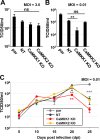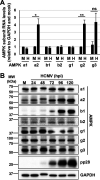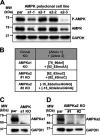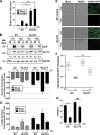Human Cytomegalovirus Induces the Expression of the AMPKa2 Subunit to Drive Glycolytic Activation and Support Productive Viral Infection
- PMID: 33268515
- PMCID: PMC8092818
- DOI: 10.1128/JVI.01321-20
Human Cytomegalovirus Induces the Expression of the AMPKa2 Subunit to Drive Glycolytic Activation and Support Productive Viral Infection
Abstract
Human Cytomegalovirus (HCMV) infection modulates cellular metabolism to support viral replication. Calcium/calmodulin-dependent kinase kinase (CaMKK) and AMP-activated protein kinase (AMPK) regulate metabolic activation and have been found to be important for successful HCMV infection. Here, we explored the contributions that specific CaMKK isoforms and AMPK subunit isoforms make toward HCMV infection. Our results indicate that various CaMKK and AMPK isoforms contribute to infection in unique ways. For example, CaMKK1 is important for HCMV infection at a low multiplicity of infection, but is dispensable for AMPK activation at the earliest times of infection, which our data suggest is more reliant on CaMKK2. Our results also indicate that HCMV specifically induces the expression of the non-ubiquitous AMPKa2 catalytic subunit, found to be important for both HCMV-mediated glycolytic activation and high titer infection. Further, we find that AMPK-mediated glycolytic activation is important for infection, as overexpression of GLUT4, the high capacity glucose transporter, partially rescues viral replication in the face of AMPK inhibition. Collectively, our data indicate that HCMV infection selectively induces the expression of specific metabolic regulatory kinases, relying on their activity to support glycolytic activation and productive infection.IMPORTANCE Viruses are obligate parasites that depend on the host cell to provide the energy and molecular building blocks to mass produce infectious viral progeny. The processes that govern viral modulation of cellular resources have emerged as critical for successful infection. Here, we find that HCMV depends on two kinase isoforms to support infection, CaMKK1 and AMPKa2. We find that HCMV specifically induces expression of the AMPKa2 subunit to induce metabolic activation and drive robust viral replication. These results suggest that HCMV has evolved mechanisms to target specific metabolic regulatory kinase subunits to support productive infection, thereby providing insight into how HCMV hijacks cellular metabolism for its replication, and sheds light on potential viral therapeutic vulnerabilities.
Copyright © 2020 American Society for Microbiology.
Figures









Similar articles
-
Inhibition of calmodulin-dependent kinase kinase blocks human cytomegalovirus-induced glycolytic activation and severely attenuates production of viral progeny.J Virol. 2011 Jan;85(2):705-14. doi: 10.1128/JVI.01557-10. Epub 2010 Nov 17. J Virol. 2011. PMID: 21084482 Free PMC article.
-
HCMV targets the metabolic stress response through activation of AMPK whose activity is important for viral replication.PLoS Pathog. 2012 Jan;8(1):e1002502. doi: 10.1371/journal.ppat.1002502. Epub 2012 Jan 26. PLoS Pathog. 2012. PMID: 22291597 Free PMC article.
-
RAF1 promotes successful human cytomegalovirus replication and is regulated by AMPK-mediated phosphorylation during infection.J Virol. 2025 Mar 18;99(3):e0186624. doi: 10.1128/jvi.01866-24. Epub 2025 Feb 4. J Virol. 2025. PMID: 39902964 Free PMC article.
-
Interplay Between Calcium and AMPK Signaling in Human Cytomegalovirus Infection.Front Cell Infect Microbiol. 2020 Jul 29;10:384. doi: 10.3389/fcimb.2020.00384. eCollection 2020. Front Cell Infect Microbiol. 2020. PMID: 32850483 Free PMC article. Review.
-
Meal for Two: Human Cytomegalovirus-Induced Activation of Cellular Metabolism.Viruses. 2019 Mar 19;11(3):273. doi: 10.3390/v11030273. Viruses. 2019. PMID: 30893762 Free PMC article. Review.
Cited by
-
The antiviral state has shaped the CpG composition of the vertebrate interferome to avoid self-targeting.PLoS Biol. 2021 Sep 7;19(9):e3001352. doi: 10.1371/journal.pbio.3001352. eCollection 2021 Sep. PLoS Biol. 2021. PMID: 34491982 Free PMC article.
-
Human cytomegalovirus induces neuronal enolase to support virally mediated metabolic remodeling.Proc Natl Acad Sci U S A. 2022 Dec 6;119(49):e2205789119. doi: 10.1073/pnas.2205789119. Epub 2022 Dec 2. Proc Natl Acad Sci U S A. 2022. PMID: 36459650 Free PMC article.
-
Multifaceted Role of AMPK in Viral Infections.Cells. 2021 May 6;10(5):1118. doi: 10.3390/cells10051118. Cells. 2021. PMID: 34066434 Free PMC article. Review.
-
Proteome-wide characterization of PTMs reveals host cell responses to viral infection and identifies putative antiviral drug targets.Front Immunol. 2025 May 30;16:1587106. doi: 10.3389/fimmu.2025.1587106. eCollection 2025. Front Immunol. 2025. PMID: 40519923 Free PMC article. Review.
-
Cytomegalovirus-induced inactivation of TSC2 disrupts the coupling of fatty acid biosynthesis to glucose availability resulting in a vulnerability to glucose starvation.mBio. 2024 Jan 16;15(1):e0303123. doi: 10.1128/mbio.03031-23. Epub 2023 Dec 20. mBio. 2024. PMID: 38117060 Free PMC article.
References
Grants and funding
LinkOut - more resources
Full Text Sources
Other Literature Sources
Research Materials

